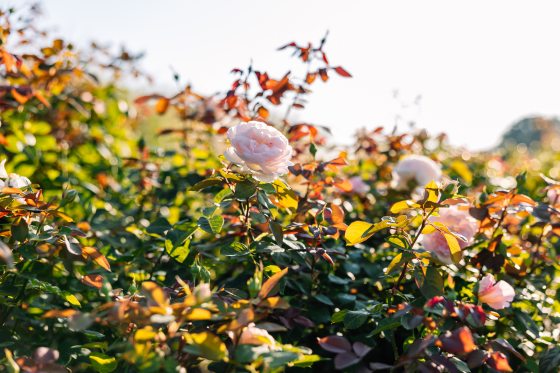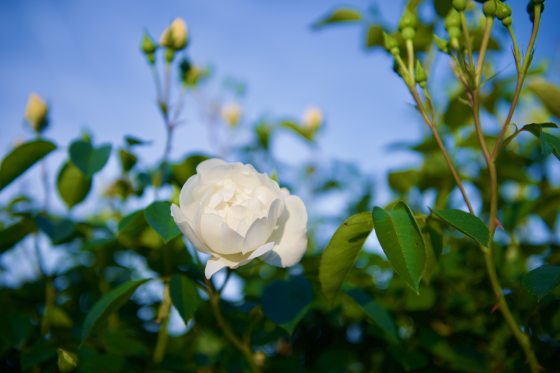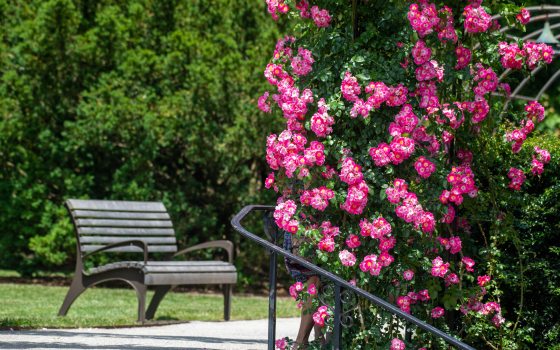The rose: a flower, a color, a smell, the name of a friend—even Shakespeare graced Juliet’s description of Romeo with “What’s in a name? That which we call a rose, by any other word would smell as sweet.” Roses are that iconic flower that is so recognizable—a symbol of elegance and timeless beauty, and a flower that is enjoyed and eagerly planted by so many. Here at Longwood, from our Rose Arbor and its seasonal explosion of pink blooms to our Rose Garden with its many different cultivars in a variety of colors—they are no different. Unfortunately, from our gardens at Longwood to your gardens at home, this iconic flower faces threats by rose rosette disease and a fungal disease called black spot. From work we do here in our Gardens to manage such threats, to our support of related research led a multidisciplinary team from nine universities and the US Department of Agriculture to deepen understanding of such diseases—we are working to ensure the longevity of this iconic plant in our Gardens and beyond. Read on for more on how you can do the same at home.

Roses in our formal Rose Garden look toward our Main Fountain Garden. Photo by Bob Doerr.
Here at Longwood, threats like rose rosette disease are managed by our plant health care (PHC) team (formerly called our Integrated Pest Management [IPM] team), focused on managing insects and diseases throughout the Gardens. They serve as entomologists, plant pathologists, biologists, virologists, and general problem solvers while maintaining the plant health care program and managing plant diagnostics in our Gardens proper, which includes greenhouses, conservatories, and outdoor landscapes. Finding success in such a varied landscape lies in a strong IPM approach that equally incorporates flexibility and preparation. Our IPM programs emphasize prevention and monitoring and often employ multiple strategies to manage pests. Instead of looking for an instant solution, we want to take a more holistic approach that considers plant health, long term sustainability, and people.
Limited to plants in the genus Rosa, with the multiflora rose as its main host, rose rosette disease is caused by a virus (Emaravirus sp.) that is spread by an eriophyid mite. Eriophyid mites are extremely small, microscopic in fact, which allows them to hide in flower buds or leaves and go virtually undetected. They are usually white or yellow in color and have a distinctive carrot-shaped body. These mites are very species-specific. The eriophyid mite responsible for spreading rose rosette disease is Phyllocoptes fructiphilus. When it feeds on a rose infected with rose rosette disease, it becomes a vector. It can then crawl or be wind-blown to a new plant where it feeds and spreads the virus. The mites can also be spread on clothing or tools, and they overwinter in the roses and begin their feeding again the following year.
Damage caused by the mite and the virus can vary from plant to plant. If your plant has rose rosette disease, you will likely see a red coloring on the leaves and an increased growth of prickles. Though prickles—sharp projections produced by a plant’s dermal tissue—are common on roses, you’ll see an amount that is excessive for the variety. The red pigmentation will not turn green with time. You’ll also see a witches’ brooming effect or a dense cluster of stems and swelling of the stems. Lastly, you’ll see flower discoloration and distortion, as well as leaf deformation. Leaves are likely to be very small and distorted and overall plant vigor and winter hardiness is reduced.

Rosa ‘AUSblush’ Heritage in our Rose Garden. Photo by Becca Mathias.
Although there is no cure for rose rosette disease, there are ways to manage for this disease. The first step with any disease management plan is prevention and, in many ways, knowledge. In order to prevent a disease, you must know about the life cycle of the disease and how it spreads and that typically begins with vector management. Knowing what populations of insects you have is a good place to start. The PHC team has a scouting program in place for our Rose Garden and our Rose Arbor, the two places in our formal Gardens where we would most likely find rose rosette disease.
Every week, our dedicated PHC scouts inspect our outdoor roses for pests. In addition to rose rosette, they are also looking for other insect and disease pests: Japanese beetle, spidermites, aphids, thrips, and black spot. We often find beneficial insects doing our pest control for us, especially on thrips. As is our strategy with all pests, we like to use multiple tools in our toolbox. One tool we use to battle mite pests is miticides. When population numbers increase, miticides may be needed.

Our Rose Arbor—seen here in spectacular bloom—is scouted diligently by our PHC team. Photo by Hank Davis.
When managing for a disease spread by an insect, a good practice is inter-planting. Removing a closely planted monoculture reduces the ability for the vector to travel easily from plant to plant. Our formal Rose Garden is isolated from our natural areas, far away from the main host: multiflora rose. In addition, our garden is interplanted with a variety of different plants, not just roses. This diversity helps eliminate host plants for the eriophyid mite.

The roses in our Rose Garden are interplanted—which not only leads to a beautifully diverse garden, but reduces the ability for a harmful vector to travel from rose to rose. Photo by Scott Hummel.
Sanitation is key in disease management. Eriophyid mites can survive in leaf litter and fallen debris and easily spread to nearby roses or be blown to other roses from that debris. When doing general garden maintenance and winter cleanup, it’s important to remember to clean up debris under your plants. Tool sanitation is also important. Clean and sanitized tools ensure that the vector and virus are not spread through tools.
When prevention like scouting, sanitation, and inter-plantings are not enough, more drastic measures might need to be taken. Despite best efforts, if our scouts do find rose rosette disease, immediate plant removal is required. For removal, a trash bag is first placed over the plant to avoid mites being inadvertently spread to other plantings. The plant is then cut at ground level and the bag tied. The entire root system is bagged and disposed of as well. During this entire process, proper PPE has to be worn, including coveralls and gloves. Thorough tool sanitation afterwards is a must.
At Longwood, teaching others about insects, diseases, and viruses is a big part of our PHC program and our team serves as extension agents for our Horticulture staff, training and teaching about pests like rose rosette disease. Through education, prevention, and swift action we work together to combat threats like rose rosette disease.

Longwood founder Pierre S. du Ponts beloved Rosa ‘Direktor Benschop’ City of York climbing rose in the Rose Garden. Photo by Xianbin Li.
While we have had great success with roses throughout our history, the opportunity to expand and grow our collection to feature cultivars that are resistant to rose rosette disease and black spot represents a sustainable step forward in our rose best management practices. To ensure the longevity of this important class of plants, inroads in both education and plant breeding are crucial—and why Longwood is in strong support of the Sustainable Rose USDA-Specialty Crop Research Initiative (USDA-SCRI) project, through which a team of scientists from nine universities and the USDA are working to identify the genes responsible for resistance to rose rosette disease—and the subsequent development of cultivars that possess combined resistance to rose rosette disease and black spot—to ensure the longevity and sustainability of rose production and gardening.
Initial trials conducted through this project give us reason to hope, as the team has seen a few species of roses and commercial rose cultivars that showed few or no symptoms of rose rosette disease. Work continues in discerning the mechanism of that presumed resistance—if it was due to factors related to virus transmission, symptom development, mite preference, or mite reproduction, among other possible factors—and the ongoing work in the Sustainable Rose USDA-SCRI project is aimed towards confirming resistance and uncovering how such resistance is inherited.
The accumulated knowledge created by this project, and those that came before it, is being utilized to combine resistance to rose rosette disease and black spot into garden roses as quickly as possible. We are grateful to this team of scientists for their dedication to ensuring that the ephemeral beauty of roses is enjoyed by generations to come—and we look forward to the opportunity to showcase resistant cultivars that come out of this work here at Longwood in the future.


